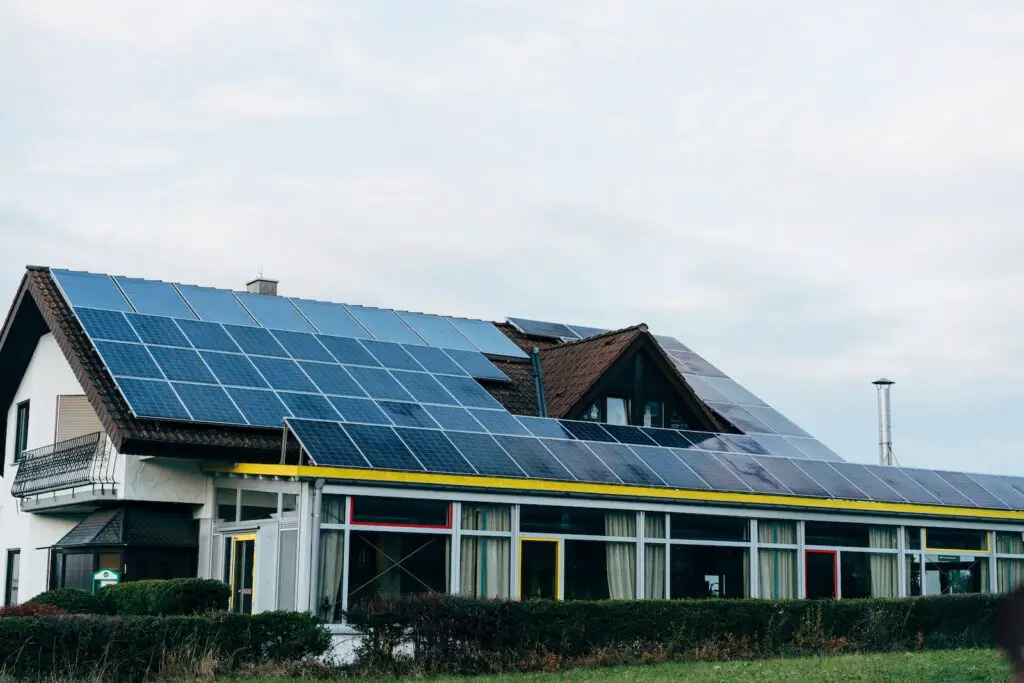Solar panels have become an essential part of the global push toward renewable energy.
By providing a clean and sustainable energy source, they reduce dependence on fossil fuels, mitigating environmental impacts.
Yes, solar panels can be used as a roof, and this approach is becoming increasingly popular as an eco-friendly energy solution.
These systems integrate solar panels directly into the roofing structure, known as solar roofs.
Solar roofs generate electricity and serve as the physical roof itself, providing shelter and protection from the elements.
The sleek design often enhances the aesthetic appeal, allowing for a seamless blend with the building’s architecture.
However, utilizing solar panels as a roof requires careful planning, design, and consideration of weight, angle, and local weather conditions.
Advantages Of Using Solar Panels As A Roof
Energy Efficiency
Integrating solar panels into the roof structure enables direct energy conversion from sunlight, reducing reliance on traditional energy sources.
This can significantly cut down on electricity bills.
Aesthetic Appeal
Solar roofs can be designed to complement the architecture of any building, creating an elegant and contemporary appearance.
Customization options may also be available depending on personal taste or to meet aesthetic standards.
Space Utilization
Solar roofs make efficient use of space by serving both as roof and power sources – particularly beneficial in urban settings where space may be at a premium.
Environmental Benefits
Solar roofs contribute to sustainability by using renewable solar energy, thus reducing greenhouse gas emissions and dependence on fossil fuels.
Increased Property Value
The integration of solar technology can enhance the value of a property, making it more attractive to energy-conscious buyers.
Potential Financial Incentives
Many governments and municipalities offer incentives and rebates for installing solar energy systems, which can offset the initial installation costs.
Durability
Modern solar roofing systems are built to be robust and durable, often withstanding harsh weather conditions.
They may contribute to the overall strength of the building’s structure.
Reduced Installation Complexity
By integrating solar panels into the roof, traditional mounting systems are eliminated, potentially simplifying the installation process.
Potential Off-Grid Capability
Depending upon its size and efficiency, solar roofing may supply enough energy for buildings to function off the grid for increased energy independence and adaptability.
Adaptability
Solar roofs can be tailored to different geographical and climatic conditions, adjusting to the specific needs and preferences of the location.
Drawbacks Of Using Solar Panels As A Roof
Initial Cost
The upfront cost of integrating solar panels into a roofing system can be higher than traditional or standard solar installations. This might include specialized design, materials, and installation.
Maintenance Complexity
Solar roofs may require specialized maintenance and regular inspections to ensure they function properly.
This could lead to higher ongoing maintenance costs of Solar Roofs.
Limited Options
Design constraints and the need for a specific orientation towards the sun might limit the architectural options for the building.
Potential Inefficiency
Depending on the roof’s design and orientation, some solar roofing systems might not be as efficient as traditional solar panel installations, potentially affecting energy generation.
Weather Vulnerability
While designed to be durable, solar roofs might be more susceptible to damage from extreme weather conditions such as hail or heavy snow.
Any damage could affect both the protective function of the solar roof and its energy generation capacity.
Specialized Installation
Integrating solar panels into the roofing system requires skilled professionals with experience in both roofing and solar energy.
This might limit the availability of qualified installers in some areas.
Potential Aesthetic Limitations
Though they can be aesthetically pleasing, the appearance of solar roofs might only be suitable for some buildings or might not align with personal preferences.
Weight Considerations
The added weight of the solar panels might require additional structural support, potentially complicating the building design or retrofitting process.
Technological Changes
The rapid evolution of solar technology might lead to more advanced solutions shortly after installation, potentially rendering the integrated system less competitive or outdated.
Energy Surplus Or Deficit
Miscalculations in energy need lead to either an energy surplus, which is challenging to store or distribute, or an energy deficit, necessitating supplementary energy sources.
Are Solar Roofs More Expensive Than Traditional Solar Installations?
Solar roofs can be more expensive initially than traditional solar installations due to specialized materials, design, and installation requirements.
However, they offer unique benefits like space efficiency and aesthetic integration.
Potential energy savings and government incentives might offset some of the higher upfront costs in the long run.
How Durable Are Solar Roofs Compared To Conventional Roofing?
Modern solar roofing systems are designed to be robust and durable, often made with tempered glass and strong framing materials.
They are built to withstand various weather conditions but might be more susceptible to certain extremes like hail.
Regular maintenance and inspection by professionals can ensure their longevity and effectiveness.
Can Solar Roofs Be Installed On Any Building?
While solar roofs offer versatility, only some buildings might be suitable.
Factors like roof orientation, angle, structural integrity, and local weather conditions must be carefully considered.
Consulting with a professional specializing in solar roofing is essential to evaluate if a particular building is a good candidate for this technology.
What Are The Maintenance Requirements For Solar Roofs?
Solar roofs may require specialized maintenance, including regular inspections, to ensure optimal functioning.
Maintenance might include cleaning the panels, checking the integrity of the connections, and monitoring the overall system performance.
Working with a qualified solar roof maintenance provider is recommended to ensure proper care and maximize the system’s lifespan.
How Does The Orientation And Incline Of A Solar Roof Affect Its Efficiency?
The orientation and incline of a solar roof have a significant impact on its efficiency.
Ideally, in the Northern Hemisphere, a solar roof should face south to capture the most sunlight throughout the day.
The incline or tilt should be optimized based on the geographical location to maximize exposure to the sun’s rays.
Incorrect orientation or incline can reduce energy conversion efficiency, potentially leading to a shortfall in energy generation.









